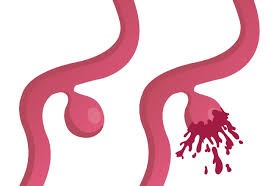Cerebral Aneurysm:
A Cerebral aneurysm or brain aneurysm is a frail or tiny spot in a blood vessel in the brain, that causes a bulge or ballooning filled with blood in the arteries. Brain aneurysms develop as a consequence of weakening artery walls. It occurs silently and can be very fatal as any burst or leak can cause brain hemorrhage (bleeding in the brain), coma, brain damage, and in extreme conditions death. But by making some variation in your lifestyle and eating habits an individual can shrink their risk of getting this disease.
Some people genetically have weak blood vessels, which can be a reason behind the growth of aneurysms but with age also a person can develop a cerebral aneurysm due to wear and tear of the artery. On many occasions, a severe head injury or infection causes the aneurysm. Therefore, it is important to identify whether the condition is inherent or susceptibility to an aneurysm.
What Causes Brain Aneurysm?
When the wall of the arteries in the brain becomes tinny and frail, it leads to a brain aneurysm or cerebral aneurysm. It usually forms at the branch in arteries, as that section is the most fragile. Sometimes, cerebral aneurysms exist from birth, generally resulting from a defect in an artery wall. Although the Brain is common, cases that are asymptomatic can only be diagnosed through autopsy. Aneurysms can rupture or leak, depending upon their characteristics like size, location, and growth, or other additional medical conditions. When it ruptures or leaks it causes symptoms such as extreme headache to stroke and can result in death as well.
The symptoms are as follows:
- Severe, sudden headache
- Nausea and vomiting
- Seizures
- Blurred vision
- Coma
- Loss of consciousness
- Paralysis on one side of the face or arm or leg
- Pain around eye
- Sensitivity to light
- Pupils dilated
- Stiffness in the neck
There are various risk factors that impact your chances of developing the ailment:
- Hypertension
- Smoking
- Age above 40
- Drug abuse
- Family history
- Serious head injury
- Women are more prone to developing aneurysms
- Poor diet
- Weak arteries caused by connective tissue condition
- Numerous cysts in the kidneys i.e. polycystic kidney disease
- Arteriovenous malformations (disruption of blood flow due to twisted snarls of veins and arteries in the brain)
- Obesity
- Strong emotions
- Other disorders such as Fibromuscular dysplasia, Marfan syndrome, Ehlers-Danlos syndrome
How to prevent Cerebral Aneurysm?
One can avoid the diseases by taking a few measures such as:
- Quitting smoking
- Incorporating a healthy lifestyle
- Keeping your blood pressure under control
- Staying away from recreational drug use
When to See a Doctor:
At any point in time, you develop an abrupt, awfully severe headache or if you have been diagnosed with one more of the above-mentioned brain aneurysm risk factors, you should see a Neurosurgeon expert immediately. Consult our team of health care providers at the Bansal Global Hospital. We at the Bansal Global Hospital have a team of specialized Neurosurgeon who focuses on complete and integrated health care service with a caring atmosphere.
Fix your appointment today and contact us at +919911062832


 MAKE AN APPOINTMENT
MAKE AN APPOINTMENT